![]() 1st Battalion 22nd Infantry
1st Battalion 22nd Infantry ![]()
The USNS General Walker
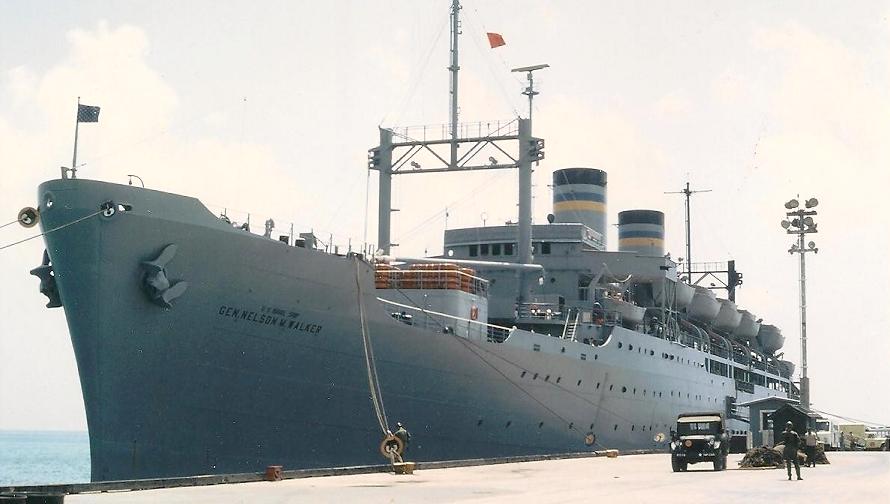
The USNS General Nelson M. Walker, seen here during her Vietnam service.
photo from the Vietnam Grafitti Project website
The US Naval Ship General Nelson M. Walker was
one of three ships that took the US Army's 4th Infantry Division
to Vietnam in 1966. On July 21, 1966 the 1st Battalion of
the 22nd Infantry Regiment sailed on the Walker from
Tacoma, Washington and sixteen days later, on August 6, 1966,
landed at Qui Nhon, Republic of South Vietnam.
The Regulars who sailed on the Walker are affectionately known as
the "Boat People" and the "Walker Babies".
The USNS General Nelson M.
Walker began life on February 21, 1944, as a troop transport for
the United States Navy.
The ship was originally named the Admiral H.T. Mayo,
and was in service with the Navy from 1945-1946.
In 1946 the "Mayo" was transferred to the United States
Army and became part of the Army Transport Service.
Renamed the USAT (United States Army Transport) General Nelson M.
Walker, the ship was in service with the Army from 1946-1950.
In 1950 she was re-classified as a U.S. Naval Ship and became
part of the Military Sea Transport Service (MSTS).
The "Walker" served as such from 1950-1959 and then
again from 1965-1968.
Specifications of the USS Admiral H.T. Mayo:
Displacement 9,676 t.(lt) 20,120 t.(fl)
Length 608' 11"
Beam 75' 6"
Draft 26' 11"
Speed 19 kts.
Complement:
Officers 52
Enlisted 596
Troop Accommodations:
Officers 270
Enlisted 4,490
Cargo Capacity 106,000 cu. ft.
Armament:
four single 5"/38 cal. dual purpose gun mounts
four twin 40mm AA gun mounts
fourteen twin 20mm AA gun mounts
Fuel Capacities:
NSFO 25,600 Bbls
Diesel 350 Bbls
Propulsion:
two General Electric turbo-electric engines
four Combustion Engineering D-type boilers, 600psi 840°
Ships Service Generators:
four 500Kw 450V A.C.
four 200Kw 120V/240V D.C.
two propellers, 18,000shp
Source:
NavSource
Naval History
Photographic History Of The U.S. Navy
History of the USNS General Nelson M. Walker
Admiral H. T. Mayo (AP-125) was laid down on 21
February 1944 at Alameda, Calif., by the Bethlehem Steel Corp.,
under a Maritime Commission contract (MC hull 683) launched on 26
November 1944, sponsored by Mrs. George Mayo
and commissioned at Alameda on 24 April 1945, Capt. Roger C.
Heimer, USCG, in command.
After fitting out, loading supplies and carrying out her
shakedown cruise out of San Diego, Admiral H. T. Mayo sailed for
European waters
on 24 May 1945, bound for Le Harve, France. Transiting the Panama
Canal between 31 May and 2 June, the transport reached her
destination
on 12 June. There she embarked 5,819 released American military
prisoners (RAMPs) and men being rotated home to the United
States,
and sailed for Boston, reaching that port on 27 June. She sailed
thence for Marseilles, France, and there embarked 4,888
Quartermaster
and Engineer troops. Delayed for repairs at that French port
Admiral H. T. Mayo did not sail for the Pacific until 10 July
1945.
She transited the Panama Canal on 21-22 July, and, sailing via
Eniwetok, in the Marshalls, and Ulithi, in the Carolines
(spending a 16-day layover at the latter place), reached her
destination, Okinawa, m the Ryukyus, on 1 September.
Eight days later, on 9 September 1945, Admiral H. T. Mayo
departed Okinawa with 5,014 passengers, officers and enlisted men
of the Navy,
Coast Guard and Marine Corps, being transferred to the United
States for discharge or reassignment under the "point"
system.
Reaching San Francisco on 27 September 1945, on the first of her
postwar "Magic Carpet" voyages, the transport there
disembarked her passengers,
and, following an availability, sailed for the Far East on 18
October. Reaching Tokyo, Japan, on 29 October and Manila,
Philippine Islands,
on 4 November, she embarked returning veterans at those two ports
and ultimately arrived back at San Francisco on 22 November.
Admiral H. T. Mayo sailed for Korean waters on 5 December and
arrived at her destination, Jinsen (now Inchon), Korea on 19
December.
She sailed thence for Japan, reaching Nagoya on Christmas Day
1945. The transport departed that port on 29 December, and,
routed via Pearl Harbor,
and diverted from her original destination, Seattle, reached
"Frisco" on 11 January 1946. Following voyage repairs
Admiral H. T. Mayo sailed for
Okinawa on 10 February, and reached her destination on
Washington's Birthday. She brought back returning veterans to
Seattle on 10 March,
and rounded out her "Magic Carpet" service with a
round-trip voyage between Yokohama, Japan, and Seattle, reaching
the latter port on 23 April 1946.
Admiral H. T. Mayo cleared Seattle on 25 April, and, after
stopping briefly at San Pedro until the 28th, pushed on for
Panama. Transiting the canal
between 4 and 6 May, the transport arrived at the New York Naval
Shipyard, on 10 May 1946 where she was decommissioned on 26 May
1946
and turned over to the War Shipping Administration, for further
delivery to the Army. Her name was struck from the Naval Vessel
Register on 9 June 1946.
Assigned to the Army Transport Service, the ship was renamed
General Nelson M. Walker,to honor Brigadier General Nelson M.
Walker (1891-1944)
who had been killed in action at Normandy on 10 July 1944. The
ship underwent repairs and conversion at the Todd Shipyard's Erie
Basin
until September 1946, after which time she sailed for the west
coast of the United States to base on Seattle.
USAT Nelson M. Walker operated from that port into mid-1948,
carrying troops to such ports and islands as Honolulu, Guam,
Saipan, Okinawa,
Yokohama, Jinsen, and Manila. In July 1948, she entered the Todd
Shipyard at San Pedro for a Safety at Sea conversion and partial
conversion
as a dependent carrier. This entailed the installation of cabin
space for 217 passengers, two lounges, and a children's playroom,
well-stocked with toys
and a ship's store, whose foremost item offered for consumption
by passengers was a "weird and wonderful concoction"
known as "Coca Cola."
Following this face-lifting, General Nelson M. Walker returned to
service on 7 December 1948 to resume her transpacific voyages.
She followed a triangular route over the next two years sailing
between San Francisco, Yokohama, and Okinawa, soon acquiring a
reputation
for speed and comfort, two attributes frequently put to the test
in Far Eastern waters where typhoons were common. With the newly
organized
Military Sea Transportation Service (MSTS), General Nelson M.
Walker's operations were soon confined to serve Okinawa
exclusively,
the regularity of her appearance on that run earning her the
affectionate title of the "Okinawa Express." She
represented to many the last connecting link
between their new domicile and CONLUS, the new term which had
begun to appear in military jargon in writing up travel orders
and standing for "Continental Limits of the United
States."
Her 27th voyage as USAT Nelson M. Walker was her last under the
banner of the old Army Transport Service, and on 1 March 1950
she became USNS (United States Naval Ship) Nelson M. Walker
(T-AP-125). She sailed on her maiden voyage as an MSTS transport
on 27 March 1950, when she departed San Francisco for Buckner
Bay, Okinawa, resuming her run as the "Okinawa
Express." On 28 April 1950,
the ship was reinstated on the Naval Vessel Register. The
outbreak of hostilities in Korea on 27 June 1950 occurred while
General Nelson M. Walker
was returning from her second Far Eastern voyage as an MSTS ship.
She sailed for Okinawa on 6 July with Army and Air Force men
and their dependents embarked, and, ten days later, after being
battered briefly by a pair of typhoons disembarked her passengers
among whom
were included key Air Force B-29 personnel, needed in the new
Korean theater of war.
As the United States began shipping men and material to support
the United Nations operations in Korea, General Nelson M.
Walker's schedule
was altered accordingly; where it had once been her major port of
embarkation/disembarkation, Okinawa was less frequented than it
had been.
During the latter part of 1950 and early 1951, General Nelson M.
Walker operated between San Francisco and Japanese ports
frequenting Yokosuka, Yokohama, and Sasebo. By the time the ship
reached Seattle on 20 January 1952, the transport had carried out
18 voyages
for MSTS. Entering the Todd Shipyard at Seattle the ship then
underwent conversion to an "austerity trooper', increasing
her cabin capacity
to 417 spaces and her troop capacity to 3 739 bunks. Gone were
the cabin lounges, recreation halls, children's playroom, some
crew's accommodations,
and storerooms. Shipboard equipment was modernized and an air
conditioning unit was added to the enlarged hospital on board the
transport.
Following this conversion, repairs, and drydocking, General
Nelson M. Walker loaded provisions and stores at Smith Cove by
the naval supply depot there,
and then shifted to berth 39, Seattle, whence she sailed on 14
April 1952 on her maiden voyage as an "austerity
trooper." En route back to the west coast
after this troop lift to Yokohama, Pusan, Inchon, and Sasebo, the
ship was informed that she would henceforth be employed taking
United Nations' troops
to Korea. She reached San Francisco on 18 May, and sailed for
Panama on the last day of May, with Puerto Rican enlisted men and
Colombian officers
and men, Korean war veterans all, as well as United States Army
troops slated to debark at Norfolk and 1,000 Army troops destined
for La Pallice.
She touched at Rodman Naval Base, Balboa, Canal Zone, and there
embarked 1,500 Puerto Rican soldiers for transportation to
Bremerhaven.
Transiting the Panama Canal on 8 June, the troopship arrived at
Cartegena, Colombia, on the 9th, pushing on later that same day
for San Juan, Puerto Rico,
arriving on 11 June. Clearing port later the same day she pushed
on for Norfolk, arriving there on 14 June and thence to La
Pallice, France,
making port on 24 June. She then made one voyage to Bremerhaven
Germany, before returning to the United States, touching at New
York,
and then carried out a second trip to Bremerhaven before she
proceeded into the Mediterranean basin, her only troop passengers
a small detachment of Dutch officers and men.
Reaching the Pireaus, the port for Athens, Greece, the transport
took on board Greek troops on 28 July, before she sailed for
Tzmir, Turkey,
arriving at that port the following morning. There she embarked
Turkish troops, the advance party on the 29th and the main body
on the 30th,
and sailed late on the latter day for the Suez Canal, the Red
Sea, and the British Crown Colony of Aden. Fueling at Aden,
General Nelson M. Walker
then proceeded on to Korea, arriving at Pusan on 21 August, her
arrival greeted by various high-ranking military officers and
United Nations
consular officials, as well as ranking members of South Korean
President Syngman Rhee's cabinet. President Rhee later arrived
and made a speech
welcoming the Greek and Turkish troops to Korea. The following
day, the transport sailed for Sasebo, Yokohama, and San
Francisco, reaching "Frisco"
on 5 September after an absence of some 95 days. Her odyssey had
taken her through the Central Pacific, the Caribbean, the North
Atlantic, the North Sea,
the Mediterranean, the Indian Ocean Philippine and South China
Seas, as well as the East China Sea, the fellow Sea, and the
Northern Pacific,
steaming some 34,575 miles and carrying a total of 17,907 people.
Significant in this voyage was the fact that that lift
"brought together, within the close
and limited confines of a troopship, members of the Armed Forces
of two nations (Greece and Turkey) whose traditional enmity
extended
over the centuries." The voyage, however, had proved an
unqualified success on all counts.
General Nelson M. Walker soon resumed her transpacific trips,
making two more round-trip voyages to and from San Francisco and
being in mid-voyage
on a third by the time the year 1952 was through. During 1953,
the transport conducted eight voyages, a period of time
highlighted by her bringing back
to the United States the first group of 328 returning American
prisoners of war from the Korean conflict. Over the next few
years, General Nelson M. Walker
maintained her regular schedule of voyages to Far Eastern ports,
her ports of call including Kobe Sasebo, Inchon, Yokohama, Pusan,
San Francisco,
San Diego, and, on one occasion, the island of Midway, through
the end of 1955, and into 1956. Departing Monterey, Calif., on 10
January 1957,
the transport sailed for Panama. She transited the canal on 17-18
January, and continued on for Bremerhaven, making arrival there
on 28 January.
Clearing that Port on 5 February, she sailed via Dover, England,
for New York, arriving on 14 February.
Two days after her arrival, on 16 February 1957, Commander MSTS,
Atlantic, assumed administrative control of the ship, and she was
placed
in ready reserve status. Records indicate that she was to be
withdrawn from that inactive status on 5 June 1958, apparently to
be inactivated
and turned over to the Maritime Administration (MarAd) for lay
up, and that she was placed in MarAd's reserve fleet on 20
January 1959,
in the Hudson River berthing area (Jones Point), near New York
City.
Reacquired by the Navy on 14 August 1965 and reinstated on the
Naval Vessel Register on the same date, General Nelson M. Walker
was taken out of the National Defense Reserve Fleet in August
1965 and reactivated as part of the buildup of naval forces for
the Vietnam War.
She was assigned to MSTS (Pacific) for trooplifts to Southeast
Asia. On 1 February 1966, while returning from that area of the
world,
she was summoned to stormy seas northwest of the Hawaiian
Islands. SS Gainesville Victory, in attempting to aid the
foundering Liberian-registry freighter
SS Rockport, had suffered casualties when a Lyle gun had exploded
as she had attempted to get a line to Rockport. General Nelson M.
Walker
provided medical advice, seas being too rough to permit transfer
of a doctor, that sufficed until the ship could reach Midway
where better medical facilities
were available. The transport stood by and, less than 12 hours
after she had arrived on the scene, had rescued all 27 men from
the sinking Rockport.
After operating with MSTS (Pacific) through the end of 1967, she
was ultimately deactivated once again and placed in reserve at
the
Caven Point Army Depot in New York harbor, in early 1968. General
Nelson M. Walker was transferred to MarAd on 16 April 1970 and
laid up
in the James River (Va.) berthing area. General Nelson M. Walker
was struck from the Naval Vessel Register in January 1981;
she remained in the James River berthing area into 1987.
from: Navy
History .com
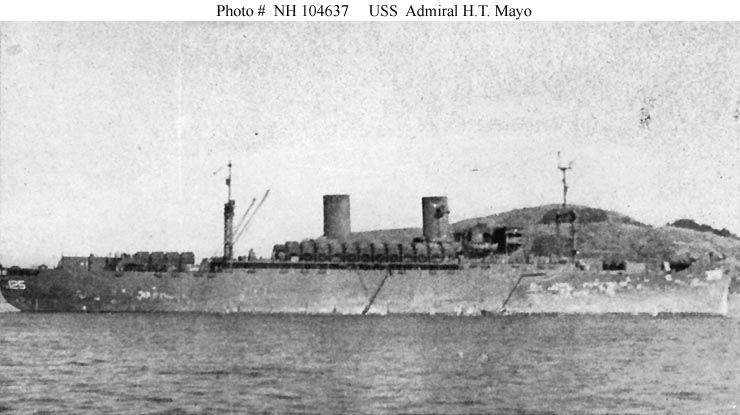
A halftone reproduction
of a photograph of USS Admiral H.T. Mayo
(AP-125) circa 1945, probably in San Francisco Bay,
CA.
Copied from the book "Troopships of World War 11", By
Roland W. Charles.
US Navy photo # NH 104637 from the collections of the US
Naval Historical Center
courtesy of Robert
Hurst
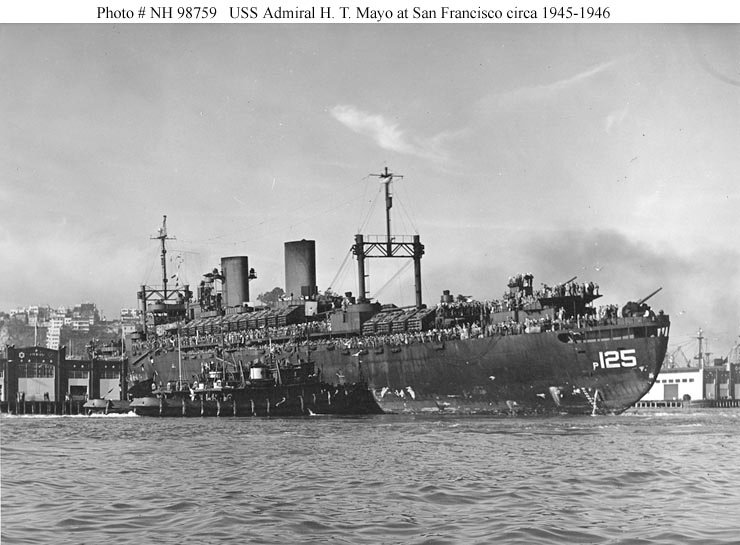
USS Admiral H.T. Mayo
(AP-125) coming alongside Pier 15 at Fort Mason, San Francisco,
CA. between September 1945
and January 1946 bringing servicemen home from the western
Pacific. Many of her approximately 5,000 passengers are topsides
watching her arrival. Note the two 5"/38 guns on her stern;
she had two more forward.
US Navy photo # NH 98759, from the collections of the US
Naval Historical Center, donation of BM1 Robert G. Tippins, USN
Ret., 2003.
US Naval Historical Center
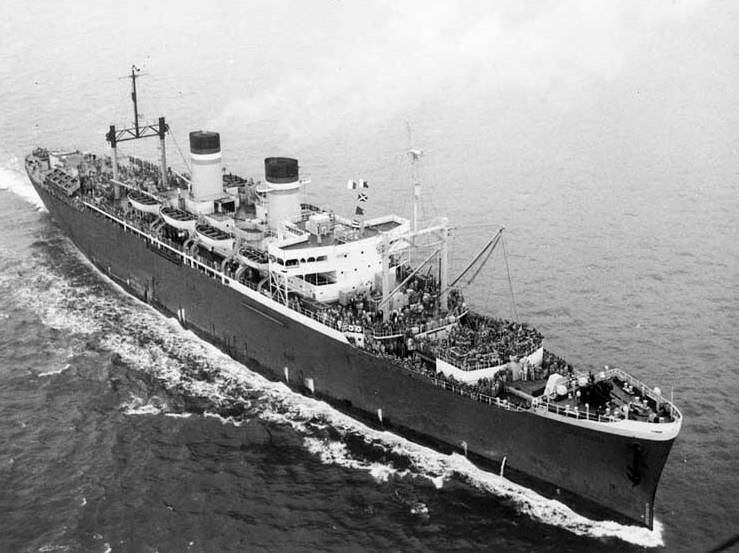
USAT General Nelson M.
Walker underway, circa 1947, location unknown.
Photo taken during the ship's service with the United States Army
US Navy photo # NH 57742 US Naval Historical Center
|
USNS General Nelson M.
Walker (T-AP-125) |
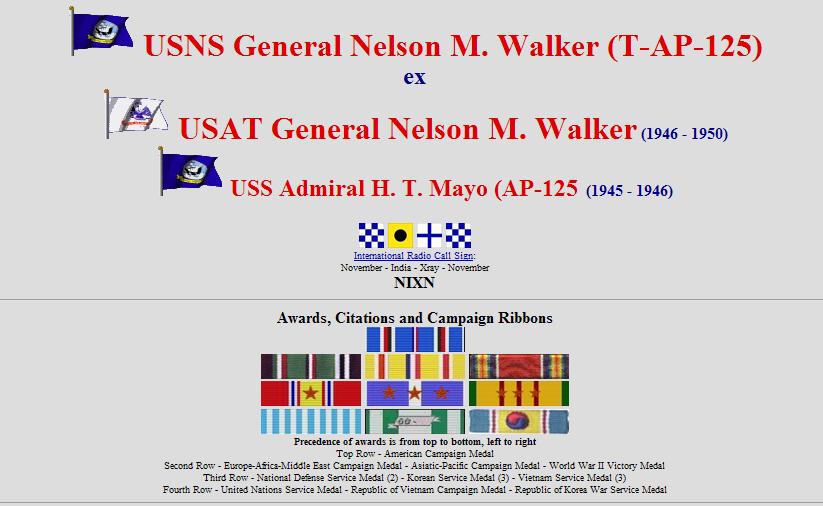
Above graphic from NavSource:
NavSource
Naval History
Photographic History Of The U.S. Navy
The Vietnam Graffiti Project
The Vietnam Graffiti Project, a non-profit 501
( C ) ( 3 ) Virginia-based organization, was established in 1997
by Art and Lee Beltrone
of Keswick, VA to preserve historic Vietnam War artifacts they
found aboard the troopship General Nelson M. Walker.
The grass roots volunteer project was formed to the assist the
Maritime Administration with removal of artifacts, including
graffiti-inscribed
berthing unit canvases, and transferal to museums throughout the
country. Recipients included the Library of Congress, Smithsonian
Institution,
museums of the military services, and state and local historical
societies.
In 2005, the Walker was scrapped in Brownsville, Texas and
project volunteers recovered hundreds of graffiti-marked canvases
and other artifacts for the VGP’s Marking Time: Voyage to
Vietnam exhibit. The exhibit was developed in partnership
with the Virginia Foundation for the Humanities.
The VGP continues to find and interview soldiers and Marines who
went to Vietnam aboard the Walker and other troopships.
Audio interviews of troop passengers are conducted with
assistance from the Virginia Foundation for the Humanities.
Voyage stories are included in the Marking Time exhibit and will
be shared with military history repositories.
The troopship General Nelson M. Walker transported soldiers and
Marines to Vietnam from West Coast ports like Tacoma,
San Francisco and San Diego. Voyages of over 5,000 miles, lasted
from 18 to 23 days.
Enlisted men, most in their late teens, slept on canvas bunks in
the ship’s lower-level, crowded berthing compartments.
It was here where the graffiti was created, mostly on outbound
voyages, but sometimes on a return voyage.
Officers were quartered in smaller and more comfortable rooms on
the upper, main deck. Virtually no graffiti was left in these
areas.
Voyages caused homesickness, seasickness, anxiety and boredom.
Some men found ways to relax and share humor.
Lifeboat drills, classes, church services, movies, music, reading
and talking to fellow soldiers helped pass the time.
The closer the men got to Vietnam the hotter it
became aboard ship, especially in the lower-level compartments
where there was little air circulation.
Open portholes in troop compartments above the waterline provided
some fresh air to those berthing areas.
Crowded conditions aboard ship created delays that lasted hours.
The slogan “hurry up and wait” was never more
meaningful.
Long lines formed for breakfast, lunch and dinner at the
ship’s mess halls. Seemingly endless lines formed to reach
the ship’s store
where candy, cigarettes and other personal items could be
purchased.
The ship often stopped at Okinawa for fuel and supplies. Troops
usually were granted a short period of “liberty,” or
leave,
before continuing to Vietnam, just days away.
Marking Time: Voyage to Vietnam
is the Vietnam Graffiti Project’s national touring exhibit,
featuring artifacts from the troopship General Nelson M. Walker.
Included in the exhibit is an original
eight-person berthing (bunk) unit recovered from the ship.
It is outfitted with original bedding and bright, orange-colored
life vests found on the Walker when the vessel was scrapped in
2005.
Historic graffiti-inscribed berthing canvases are included for
wall display, and personal stories of soldiers and Marines
who made voyages from late 1965 to the end of 1967 can be heard
at audio stations.
Canvases with graffiti representing states where the exhibit
appears are used whenever available.
Small artifacts include personal items left behind by soldiers
and Marines on their way to Vietnam.
Ship safety objects and cleaning supplies are exhibited to
interpret the voyage experience.
The VGP’s Marking Time: Voyage to Vietnam
traveling exhibit opened in 2007 at the United States Navy
Memorial, Washington, DC,
and has since appeared at venues throughout the nation. Two
traveling exhibit units, each featuring an original eight-person
berthing (bunk) unit,
graffiti-inscribed canvases and artifacts, are currently touring
the country.
Source: the Vietnam Grafitti Project website
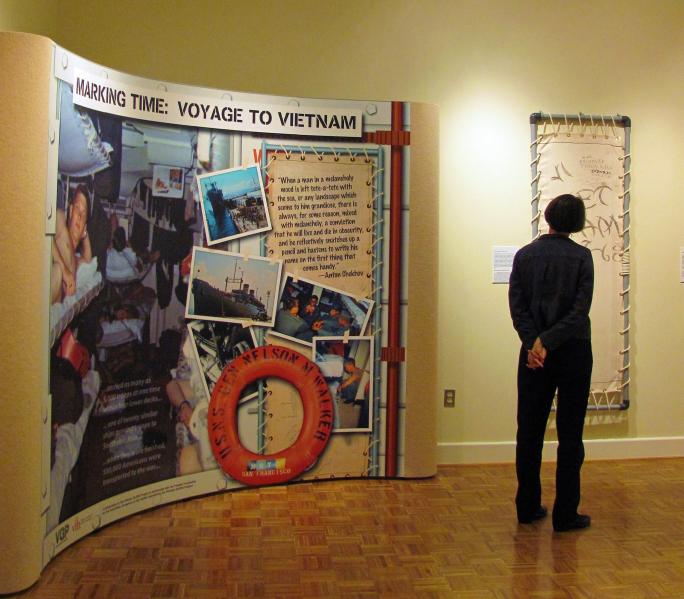
Part of the exhibit from Marking
Time: Voyage to Vietnam
Photo from the Vietnam Grafitti Project
website
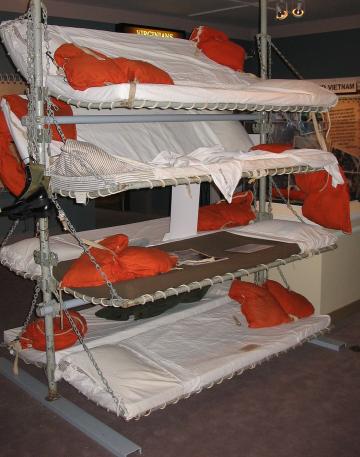
An eight person berthing unit from the
"Walker".
Photo from the Vietnam
Grafitti Project website
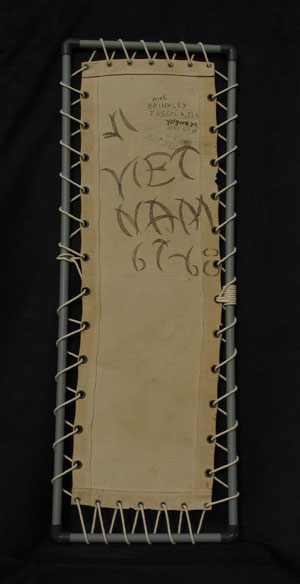
Grafitti inscribed berthing canvas from
the "Walker"
Photo from the Vietnam
Grafitti Project website
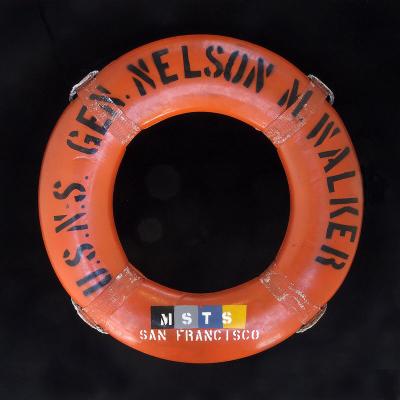
Life preserver from the
"Walker".
Photo from the Vietnam
Grafitti Project website
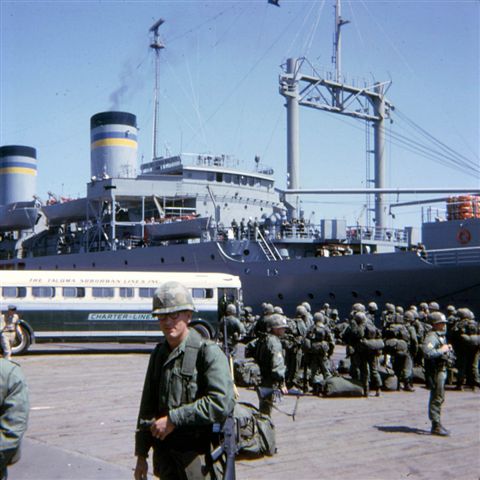
LT Robert Babcock and Company B 1/22
Infantry prepare to board the Walker
for the trip to Vietnam July 21, 1966
Photo courtesy of Bob Babcock
First Aid kit from the Walker -
front view |
First Aid kit from the Walker -
rear view |
|
Contents of First Aid kit from the Walker This kit is in the collection
of Photos by Michael Belis |
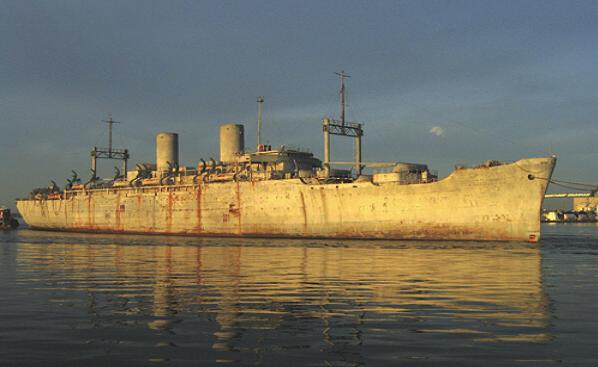
The rust streaked GENERAL NELSON M.
WALKER is freed from layup and is shown under tow on the James
River
as she heads for the breakers at Brownsville, TX.
Photo and copyright Peter Knego 2005.
Final Years
The Walker joined the Maritime Administration's
James River, Virginia, reserve fleet in April 1970 and was
formally transferred to the
Maritime Administration in July 1971. The transport was stricken
from the Naval Vessel Register in January 1981 to clear the way
for transfer to a private organization for operation as a
hospital ship, but the transfer did not materialize. In December
1994 the Navy passed
full ownership of the ship to the Maritime Administration, which
put her on indefinite hold for possible use in civil emergencies.
The hold was lifted
in September 1998 and the ship was ready for disposal by June
2001. In January 2005, nearly a half-century after completion,
General Nelson M. Walker
was towed out of the James River Reserve Fleet en route to All
Star Metals, Brownsville, Texas where she was broken up for
scrap.
from: Wikipedia
**********************
The U.S.N.S. Nelson M. Walker
was named for Nelson M. Walker who served in the United
States Army from 1917 to 1944.
Nelson Macy Walker was born on September 27, 1891 in Pittsfield,
Berkshire County,
Massachusetts, the son of Elliot and Alice Walker. He attended
Officers Training Camp at
Plattsburg Barrack, New York and was commissioned a 2nd
Lieutenant in the Officers Reserve
Corps on August 15, 1917. The date of his assignment to the 47th
Infantry could not be
determined but he is indicated in the official history of the
47th Infantry in World War
One as being with the Regiment at Camp Greene, North Carolina
before its deployment
overseas. He was commissioned a 2nd Lieutenant in the Regular
Army on May 1, 1918.
Walker sailed to France as a 2nd Lieutenant of the 47th Infantry
and part of the advance
detachment of the 4th Division aboard the troop transport U.S.S.
Kroonland on April 30,
1918. He served in the Aisne-Marne Offensive and the Vesle
Sector. He was promoted to the
temporary rank of 1st Lieutenant on August 13, 1918. He served in
the Toulon Sector, the
St. Mihiel Offensive and the Meuse-Argonne Offensive. During the
Meuse-Argonne Offensive
he was wounded by gas. He served on occupation duty in Germany
with the 4th Division.
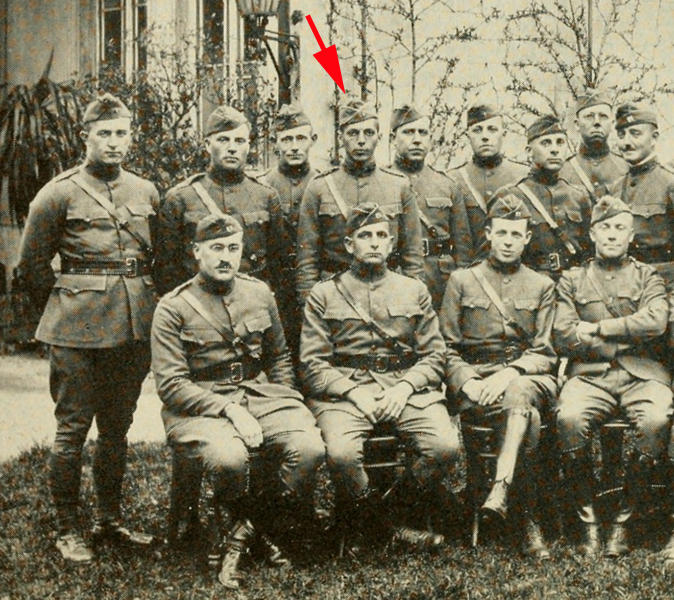
Above: A group of officers of the 47th Infantry. Red arrow points to 1st Lieutenant Nelson M. Walker
Photo from the official history of the 47th Infantry in World War One
Walker returned to the United
States as a 1st Lieutenant in Headquarters Company 47th
Infantry with his Regiment aboard the troopship U.S.S. Mobile
(seized German liner
Cleveland) leaving Brest, France July 16, 1919 and arriving at
Hoboken, New Jersey July
27, 1919. He was promoted to the permanent rank of 1st Lieutenant
in the Regular Army on
October 9, 1919 and to Captain on July 1, 1920. In 1921 he
married Doris Vanwyke and in
1923 they had twins, a boy and a girl.
|
Left: Captain Nelson M. Walker Photo from The Doughboy 1924 |
Walker attended the Infantry School Officers Course in 1924, the
General Staff School in
1930 and graduated from the Army War College in 1933. From 1933
to 1936 he was a member of
the General Staff Corps being promoted to Major on August 1,
1935. In 1935 he was awarded
the Purple Heart for the wounds he received in World War One. He
was promoted to
Lieutenant Colonel on August 18, 1940. On December 24, 1941 he
was promoted to the wartime
temporary rank of Colonel. He was promoted to the wartime
temporary rank of Brigadier
General on September 11, 1942.
Walker was assigned as Assistant Division Commander of the 8th
Infantry Division and
trained with the Division in Ireland in early 1944. He deployed
with the Division to
France on July 4, 1944. The Division saw its first day of combat
in Normandy on July 7.
Walker was seriously wounded two days later on July 9, 1944 and
died the following day on
July 10. The following is a description of the action in which he
was wounded:
“When the 121st
Infantry Regiment of the 8th Infantry Division was held up by
heavy
casualties, General Walker went forward to the regimental
headquarters to see if he could
get the unit moving forward. The Division Commander, MG William
C. McMahon, believed that
their orders to perform direct frontal attacks on the hedgerows
was causing the higher
casualties and slower advance. When BG Walker arrived at the
front line to investigate, he
found that Company E, 121st Regiment had been pinned down for two
days by heavy German
fire, just south of the main road between La Haye Du Puis and
Carentan.
The 121st appeared highly disorganized. BG Walker joined them for
evening meal, and then
went to Company E, to see if he could get the unit to move
forward. He was assisted by two
aides, LT Stephen S. Fry and LT Emmet Fields. Taking a platoon
with him, he led them
through gaps in two hedgerows, approaching where small arms fire
was heard. Cutting
through another gap in the next hedgerow, the men were suddenly
met with heavy automatic
fire from Germans and immediately six of the soldiers, including
BG Walker, were wounded.
LT Fry thinks General Walker was hit with the first shot. Both
Fields and Fry crawled
along the hedgerow and took cover behind a high dirt mount. Fry
went back to find an aid
man to help the general while Fields remained in cover to guide
the aid men when they
returned. It took some time but Fry returned with a field
ambulance and three aid men,
with whom they brought General Walker into safety on a stretcher.
On the way back to the
aid station, the medics administered plasma. The bullet had
penetrated the General’s right
thigh and hip socket, breaking his pelvis, and causing great loss
of blood and pain. He
was wounded at 11:00 pm, and would die at 1:30 am the next
morning, 10 July 1944.” *
* From Kit and Morgan Benson from the Find A Grave website
Right: Brigadier General Nelson M. Walker From The Berkshire Evening Eagle Pittsfield,
Massachusetts |
|
2nd Lieutenant Perrin Walker,
the son of Nelson M. Walker and at the time aide to Major
General William C. McMahon, the Commander of the 8th Infantry
Division was the officer in
charge of the investigation into the death of Brigadier General
Walker. For the actions
which cost him his life Nelson M. Walker was awarded the
Distinguished Service Cross in
Headquarters Ninth U.S. Army General Orders No. 29 (1944).
Walker was buried in Block K Row 1 Grave 1 in the American
Military Cemetery, Blosville
Cemetery at Carentan, France. After the end of the war his
remains were reinterred in Plot
B Row 23 Grave 47 in the Normandy American Cemetery and Memorial,
Colleville-sur-Mer,
Departement du Calvados, Basse-Normandie, France. In addition to
the Distinguished Service
Cross Walker also received the Legion of Merit, the Bronze Star
Medal, the Purple Heart
with oak leaf cluster, Chevalier of the French Legion of Honor
and the French Croix de
Guerre with palm.
|
Left: Newspaper clipping of photo of As posted by usafdo on the |

Brigadier General Nelson M. Walker's decorations
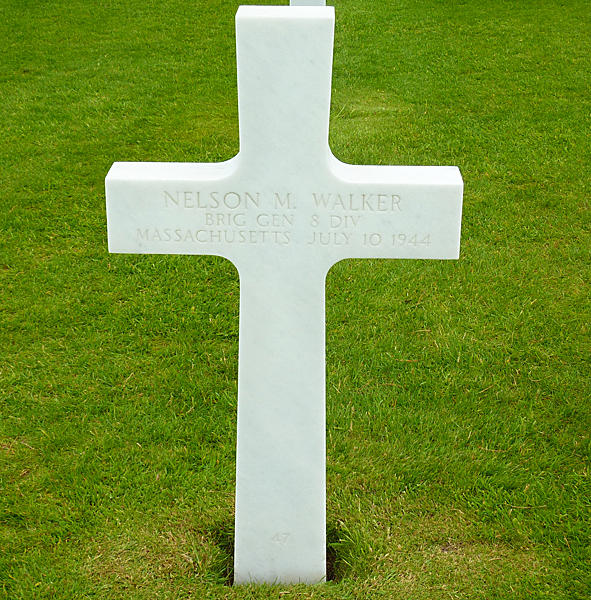
Grave marker for Brigadier General Nelson M. Walker
Photo by Woose from the Find A Grave website
**********************
Home | Photos | Battles & History | Current |
Rosters & Reports | Medal of Honor | Killed
in Action |
Personnel Locator | Commanders | Station
List | Campaigns |
Honors | Insignia & Memorabilia | 4-42
Artillery | Taps |
What's New | Editorial | Links |